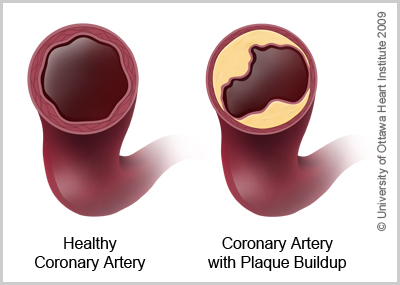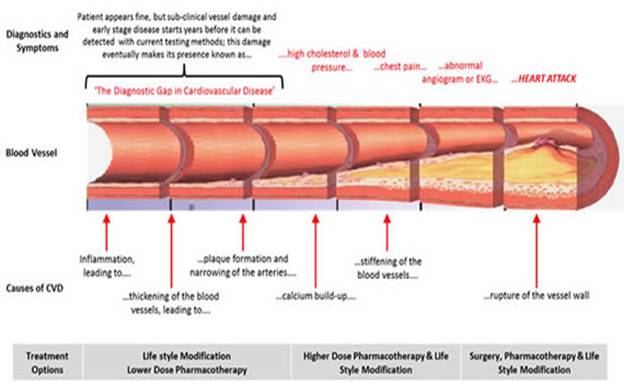1.0 WHAT IS CARDIOVASCULAR DISEASE?

Heart disease, also known as cardiovascular disease (CVD), is a general term for a variety of conditions that affect the heart and blood vessels. It is a chronic disease that can lead to heart attack and even death. Heart disease is the second leading cause of death in Canada and the first worldwide. The most common form of heart disease is coronary artery disease, which results from atherosclerosis, also referred to as hardening (and narrowing) of the arteries.
Coronary artery disease is the result of a combination of genetic and lifestyle factors. These are called risk factors.
Although the exact process that causes atherosclerosis isn’t known, over time, unhealthy behaviours lead to damage within the lining of the artery walls, encouraging plaque buildup. Plaque is made of several substances, including cholesterol. This buildup is what causes the arteries to narrow, leading to atherosclerosis, and it can start at an early age.
Atherosclerosis can cause a narrowing in the arteries (see diagrams) throughout the cardiovascular system, which can slow or block blood flow. Poor blood flow to the brain can result in stroke. Chronically poor blood flow to the arms or legs is called peripheral artery disease. Coronary artery disease inhibits blood flow to the heart and can cause angina or a heart attack.

It’s important to identify cardiovascular disease as early as possible to prevent and reduce further damage. Also critical is understanding how risk factors affect the development of CVD in the first place:
- Risk factors for cardiovascular disease are present as early as age 20.
- Most Canadians have at least one risk factor for CVD.
- Reducing risk factors before the first heart attack or stroke can prevent or postpone 33% of all deaths.1
- Reducing risk factors for cardiovascular disease also reduces the risk of death from other chronic diseases.1
- Women and men share most risk factors, but the significance of these risk factors are different:
- Smoking is particularly harmful in young women.
- High blood pressure, diabetes, and high cholesterol have a greater impact on women than they do on men and are more likely to cause complications.
- Stress, depression, and anxiety put more women at risk than men.
2.0 PREVALENCE OF CARDIOVASCULAR DISEASE
Cardiovascular disease has a large impact on the health of Canadians. It claims the lives of approximately 70,000 Canadians each year, and 1.6 million people across Canada are living with the disease or the effects of stroke. Although risk factor management strategies have been successful in reducing CVD in recent decades (25% reduction over the past 10 years and 50% reduction over the past 20 years), it’s likely to remain the second leading cause of death for years to come.
A large percentage of the population is at risk of developing CVD or experiencing a second heart attack, stroke, or other CVD-related crisis. Without an eye toward prevention, the aging process and rise in diabetes and obesity will likely increase CVD rates.
- Nine in 10 Canadians older than age 20 have at least one risk factor for CVD.
- Four in 10 Canadians have three or more risk factors for CVD.2
- There are 34.6 million visits each year to a physician for the management of CVD.
- CVD is the leading cause of death, disability, and hospitalization within Ontario and the Champlain region.
- 90,000 residents are living with CVD in the Champlain region.3
3.0 COST OF CARDIOVASCULAR DISEASE
Despite the fact that, in Canada, cardiovascular disease is second only to cancer in the lives it takes, most people aren’t aware of the threat. CVD places a high financial burden on society and has a significant impact on quality of life. It is the most costly chronic disease the Canadian health care system faces, as the following points illustrate:
- Cardiovascular disease contributes as much as $22.2 billion to health care costs each year.2
- Currently, 7.6 billion is spent annually to treat CVD in Ontario.4
- Cardiovascular disease and stroke are the leading causes of hospitalization in Canada (16.9%).5
4.0 IMPORTANCE OF CARDIOVASCULAR DISEASE
According to the World Health Organization, 24% of the current global population is made up of people older than age 55. It is estimated that within about 25 years, the percentage will double. The resulting burden on the health care system could be overwhelming.
As you age, your risk for CVD increases. This is a result of physiological changes and uncontrolled risk factors — particularly diabetes and obesity. Although the risk for CVD begins in the second decade of life and the disease is not restricted to older people, the aging process has a clear impact on cardiovascular health.
Added to the expected worldwide health burden of our aging population is the prevalence of obesity and physical inactivity among children, which seems likely to mean an even greater future uptick in cardiovascular disease and shorter life expectancies. If current projections are correct, today’s children may live two to five fewer years than their parents. However, it’s believed that the CVD risk factors associated with this particularly sedentary generation could be reversed with healthy lifestyle habits started early in adulthood.
We know a lot about the risks for CVD and how to manage the disease. Still, many of us continue to make unhealthy lifestyle choices.
The many risk factors for cardiovascular disease are divided into two categories: those that are modifiable, or changeable, and those that are non-modifiable, or unchangeable.
Early diagnosis and treatment of the modifiable risk factors can significantly reduce the chances you’ll experience a first heart attack, stroke, or other CVD crisis.
The risky lifestyle choices Canadians are making can be seen in these statistics:
- Roughly 49.5% of the Canadian population fails to get the recommended amount of physical activity.
- 42% of the residents in the Champlain region do not engage in regular exercise.
- 56.2% of the Canadian population consumes fewer than five servings of fruit and vegetables a day.
- 51% of Canadians age 18 or older — and 62.2% of Canadians ages 55 to 64 — are overweight or obese, increasing their risk for diabetes, high cholesterol, and high blood pressure.
- 48% of residents in the Champlain region are overweight or obese.
- Canadians ages 75 to 84 have the highest incidences of diabetes in Canada.
- 5.2% of residents in the Champlain region have diabetes.
- 18.8% of women and 17.3% of men in Canada have high blood pressure.2
- 14.3% of residents in the Champlain region have high blood pressure.
- 16.7% of the Canadian population is made up of daily smokers; smoking increases the risk for high blood pressure and narrowing of the arteries.
- 15.9% of residents in the Champlain region are daily smokers.2, 3
Up to 80% of CVD could be avoided if more people, including health care providers, took seriously the very real dangers of heart disease. Even those who know the risks or are, in fact, living with the disease have difficulty acknowledging that CVD poses any real threat to health. This indicates the gap between an individual’s perceived and actual risk.
Cardiovascular disease is often seen as merely an incident, rather than a chronic problem, particularly in the case of heart attack or stroke. The treatment of these acute episodes is viewed as a cure. Patient education is key to changing this view and to the adoption of heart-healthy lifestyles that will decrease lifetime risk.
With a continuous effort put behind education and awareness, there can only be improvement in the perceptions, understanding, care, and outcomes related to cardiovascular disease.
References
1. Kottke, T., Faith, D., Jordan, C., Pronk, N., Thomas, R., & Capewell, S. The comparative effectiveness of heart disease prevention and treatment strategies. American Journal of Preventive Medicine. 2009; 36 (1): 82-88.
2. Dai S, Bancej C, Bienek A, et al. Report summary: tracking heart disease and stroke in Canada, 2009. Chronic Diseases in Canada. 2009; 29 (4): 192-195.
3. Public Health Agency of Canada. (2009). 2009 Tracking Heart Disease and Stroke in Canada. Retrieved from http://www.phac-aspc.gc.ca/publicat/2009/cvd-avc/report-rapport-eng.php.
4. Champlain Cardiovascular Disease Prevention Network. (2008) Atlas of Cardiovascular Health in the Champlain District 2008.
5. Health Canada- Heart and Stroke Foundation. Statistics. Retrieved from http://www.heartandstroke.on.ca/site/c.pvI3IeNWJwE/b.3581729/k.359A/Statistics.htm

